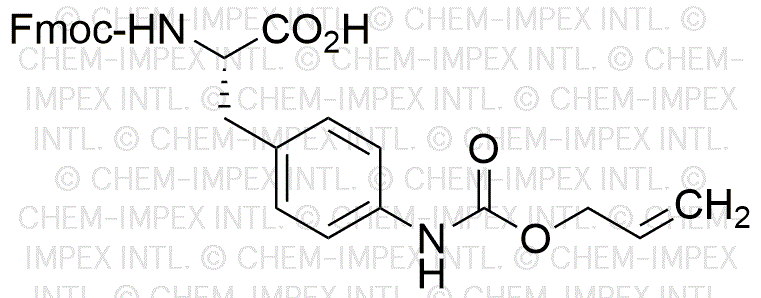Fmoc-4-Allyloxymethyl-L-phenylalanine is widely utilized in research focused on:
- Peptide Synthesis: This compound serves as a protective group in solid-phase peptide synthesis, allowing for the selective modification of amino acids. Its stability under various conditions makes it ideal for creating complex peptides.
- Drug Development: In pharmaceutical research, it plays a crucial role in the design of peptide-based drugs, enhancing their stability and bioavailability, which is essential for effective therapeutic applications.
- Bioconjugation: The compound is used in bioconjugation strategies to attach peptides to other biomolecules, improving targeting and efficacy in drug delivery systems, particularly in cancer therapies.
- Research in Protein Engineering: It assists researchers in modifying proteins to study structure-function relationships, enabling advancements in biotechnology and synthetic biology.
- Development of Diagnostic Tools: The compound is employed in the creation of peptide-based diagnostics, which can lead to more accurate detection methods for various diseases.
General Information
Properties
Safety and Regulations
Applications
Fmoc-4-Allyloxymethyl-L-phenylalanine is widely utilized in research focused on:
- Peptide Synthesis: This compound serves as a protective group in solid-phase peptide synthesis, allowing for the selective modification of amino acids. Its stability under various conditions makes it ideal for creating complex peptides.
- Drug Development: In pharmaceutical research, it plays a crucial role in the design of peptide-based drugs, enhancing their stability and bioavailability, which is essential for effective therapeutic applications.
- Bioconjugation: The compound is used in bioconjugation strategies to attach peptides to other biomolecules, improving targeting and efficacy in drug delivery systems, particularly in cancer therapies.
- Research in Protein Engineering: It assists researchers in modifying proteins to study structure-function relationships, enabling advancements in biotechnology and synthetic biology.
- Development of Diagnostic Tools: The compound is employed in the creation of peptide-based diagnostics, which can lead to more accurate detection methods for various diseases.
Documents
Safety Data Sheets (SDS)
The SDS provides comprehensive safety information on handling, storage, and disposal of the product.
Product Specification (PS)
The PS provides a comprehensive breakdown of the product’s properties, including chemical composition, physical state, purity, and storage requirements. It also details acceptable quality ranges and the product's intended applications.
Certificates of Analysis (COA)
Search for Certificates of Analysis (COA) by entering the products Lot Number. Lot and Batch Numbers can be found on a product’s label following the words ‘Lot’ or ‘Batch’.
Numéro de catalogue
Numéro de lot/série
Certificates Of Origin (COO)
This COO confirms the country where the product was manufactured, and also details the materials and components used in it and whether it is derived from natural, synthetic, or other specific sources. This certificate may be required for customs, trade, and regulatory compliance.
Numéro de catalogue
Numéro de lot/série
Safety Data Sheets (SDS)
The SDS provides comprehensive safety information on handling, storage, and disposal of the product.
DownloadProduct Specification (PS)
The PS provides a comprehensive breakdown of the product’s properties, including chemical composition, physical state, purity, and storage requirements. It also details acceptable quality ranges and the product's intended applications.
DownloadCertificates of Analysis (COA)
Search for Certificates of Analysis (COA) by entering the products Lot Number. Lot and Batch Numbers can be found on a product’s label following the words ‘Lot’ or ‘Batch’.
Numéro de catalogue
Numéro de lot/série
Certificates Of Origin (COO)
This COO confirms the country where the product was manufactured, and also details the materials and components used in it and whether it is derived from natural, synthetic, or other specific sources. This certificate may be required for customs, trade, and regulatory compliance.

